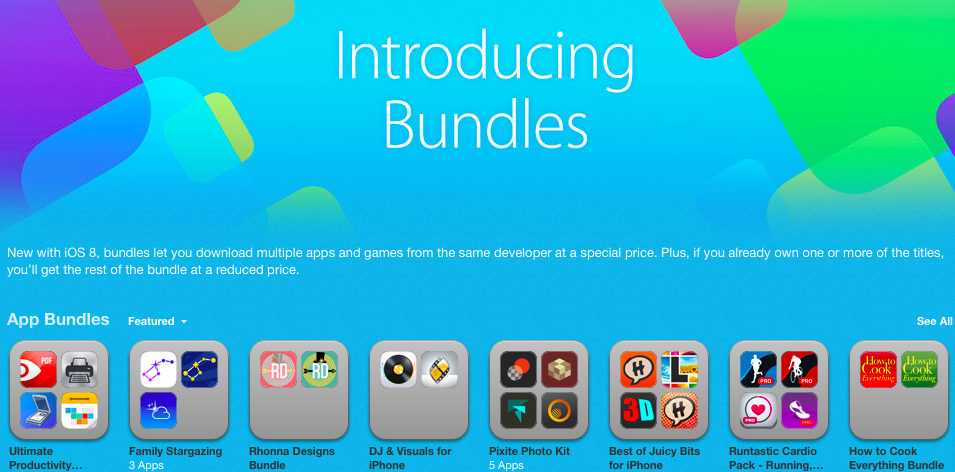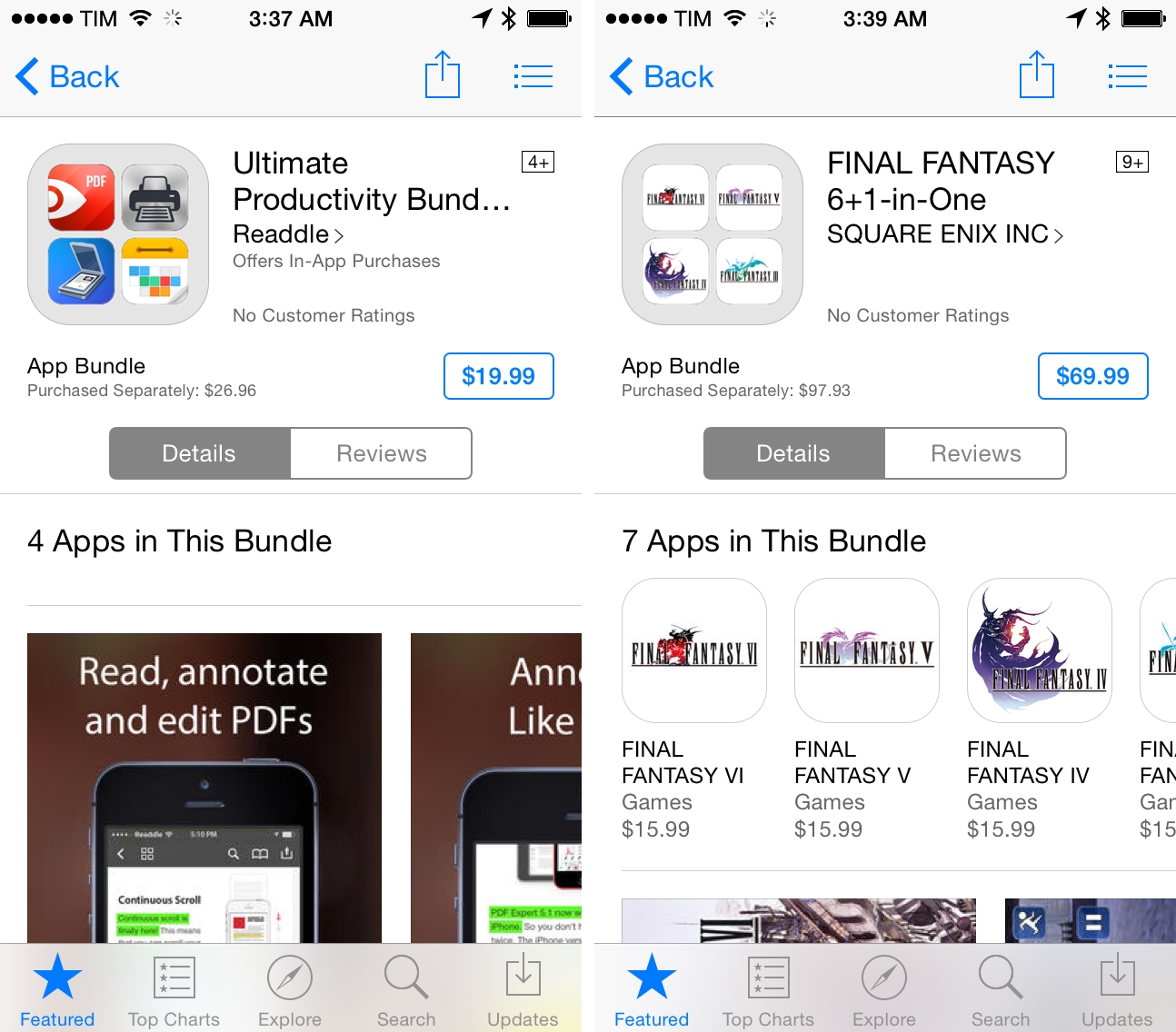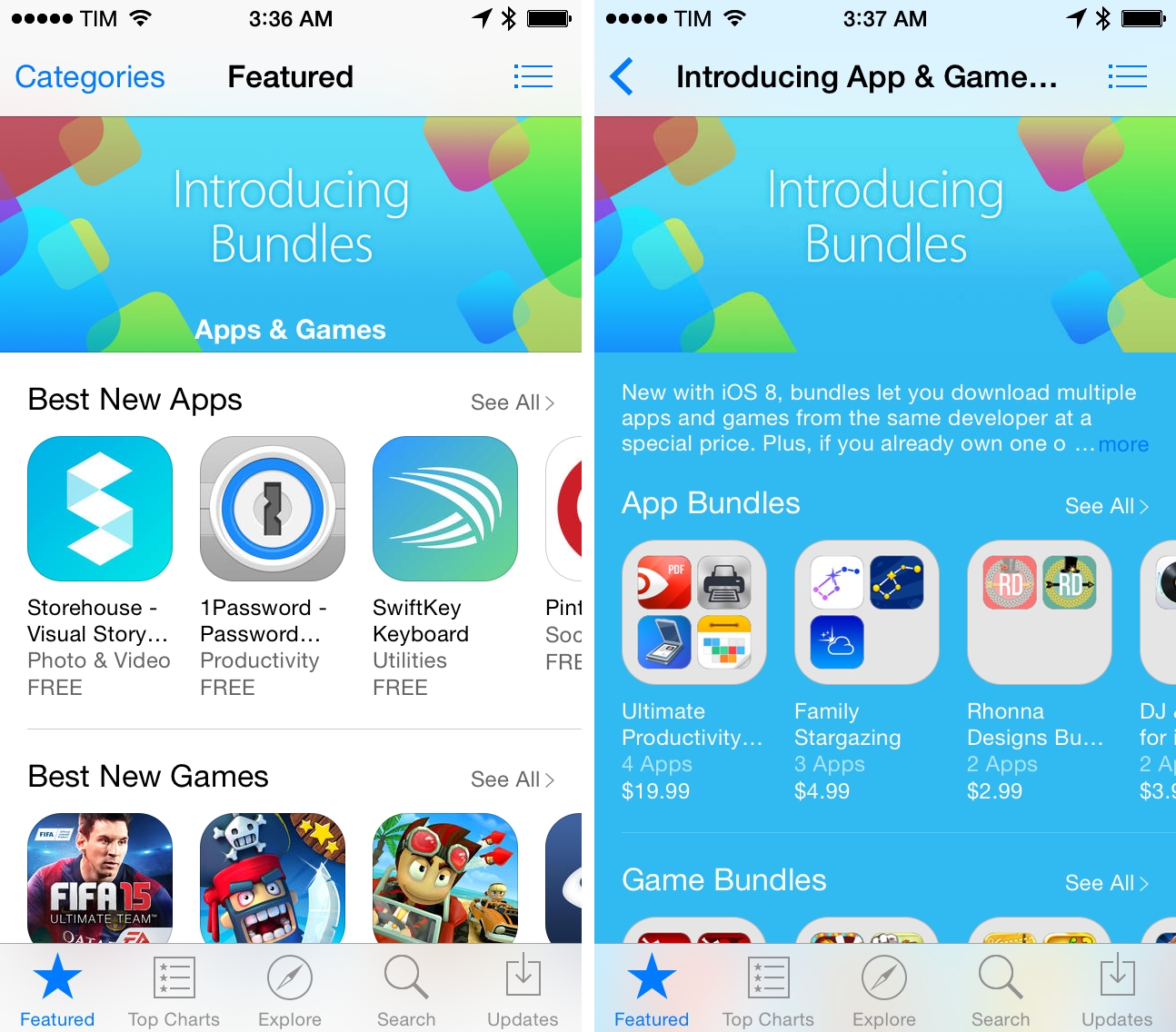With the release of iOS 8 last week, Apple launched app bundles, a new way for users to buy up to 10 apps from the same developer with a single purchase at a discounted price.
Officially introduced at WWDC 2014 as a feature of the new iTunes Connect, bundles mark a significant change for Apple’s App Store since its opening in 2008: for the first time, developers can market their apps through discounts that can be configured in iTunes Connect rather than organize independent promotions based on price drops; from a user’s perspective, app bundles are reminiscent of Apple’s Complete My Album feature of the iTunes Store.
Shortly after the debut of iOS 8, Apple created a special App Store page showcasing popular bundles for apps, games, and apps for kids. Bundles are easy to spot on the App Store: like folders on iOS, a bundle’s icon is a container of apps inside the bundle, showing a preview of the first four apps included in the bundle; a special badge indicates the number of apps in the bundle; and, only paid apps from the same developer can be part of a bundle – you won’t be able to find games from EA and Ubisoft or apps from Readdle and Runtastic in the same bundle. Since last week, Apple has been heavily promoting productivity bundles from Readdle and Pixite, games from Square Enix and Disney, and apps by Toca Boca and Diptic.
Following the launch of bundles, I’ve been talking to several developers who collected some of their apps in bundles, gauging their reactions to this new feature of the iOS 8 App Store and their thoughts on Apple’s promotional push so far.
An Encouraging Launch
“Bundles have been amazing for us - basically, doubled our sales”, Eugene Kaneko, co-founder of Pixite, told me over email. Pixite, an independent studio based in San Diego, California, makes popular photo editing apps Fragment, Union, and Matter. With the release of iOS 8, Pixite updated Fragment to support a photo editing extension and launched a Pixite Photo Kit bundle that includes 5 of their apps at $7.99 instead of $9.95.
Kaneko noted that his team was skeptical about bundles initially: Pixite customers are used to paying $2 for each app, and the $8 price tag for a bundle could turn people off. “I was sure that bundles would have a big impact on sales”, he added, although he shared a common sentiment with other developers: Apple’s big promotion on the App Store’s front page is helping right now, but will bundles be sustainable – or discoverable – in the long term?
Founded in 2007 after Apple’s introduction of the original iPhone, Readdle has grown from four people trying to make a living with simple iPhone apps to a 50-employee startup that develops a variety of productivity-oriented apps such as PDF Expert, Scanner Pro, and Documents. Readdle is one of the most popular success stories of the App Store: without being based in the Silicon Valley (Readdle operates in Odessa, Ukraine), Readdle apps have been downloaded over 30 million times from customers around the globe. With iOS 8, the company adopted a simple but effective strategy: their apps have been updated to support new iOS 8 features, and four of them have been included in a Ultimate Productivity Bundle available on the App Store for $19.99 (instead of $27).
“To say the least, our bundles did incredibly well”, Denys Zhadanov, Marketing Director at Readdle, told me earlier this week. “In terms of performance, we were able to get into top 7 Productivity chart in the US, and that’s at a $19.99 price tag”, Zhadanov said, adding that 25% off the regular retail price for individual apps proved to be a good deal for App Store customers who didn’t own all of Readdle’s iOS apps before. Sales of Calendars 5 sales grew 250%, largely because of the bundle.
Encouraging sales numbers haven’t only been reported by developers of productivity apps. Mat Peterson of Australia-based Shiny Things told me that bundles doubled the company’s revenue overnight. Shiny Things makes apps for kids such as Quick Math and Quick Clocks (grouped in a Quick Math Pack sold at $4) and Shiny Party and Shiny Circus, which have been included in a Kids Preschool Learning Pack available at $4.99. Peterson noted that bundles made up “close to 70%” of Shiny Things’ revenue over the launch weekend, “partly due to featuring, but also due to marketing to the existing customer base”.
Similarly, Sago Sago CEO Jason Krogh told me that “bundles have performed very well over the first week with Sago Sago overall revenues up more than 30%”. Sago Sago makes apps for toddlers and preschoolers, and they have launched two bundles on the iOS 8 App Store: Sago Mini Starter Pack – a collection of 4 apps sold at $4.99 – and Sago Mini Amazing Eight – 8 apps at $14.99.
Notably, bundles appear to be working well for larger companies as well: earlier this week, Rovio’s Angry Birds Ultimate Slingshot Bundle was sitting at #12 in the Top Paid chart of the iPad App Store, with bundles from Toca Boca, ZeptoLab, and Disney following with price tags of $4.99 and $7.99 in charts usually dominated by apps sold at $0.99 or $1.99.
A Developer’s Ecosystem
According to developers I spoke with, the big appeal of bundles isn’t the discount per se, but rather the discount applied to a set of complementary apps made by the same developer. That’s a subtle difference, but customers may feel like they’re getting a good deal on apps that work well together and that are made by developers they already know and trust.
Readdle is a good example of this theory. In their Ultimate Productivity Bundle, the company included four of their most popular apps; three of them – PDF Expert, Printer Pro, and Scanner Pro – come with a feature that lets them easily collaborate on the same file with a consistent and powerful workflow. Therefore, buying the Readdle bundle not only gives customers a discount on solid productivity apps – it’s a cheaper entry ticket to an ecosystem of Readdle apps that have been maintained and refined over the years.
“Bundles do make sense with iOS 8, since apps are much more interconnected now. Extensions, widgets and URL schemes make the whole work process frictionless and smooth”, Zhadanov said, noting that the promo video the company created is a great demonstration of the capabilities unlocked by purchasing apps in the Readdle bundle. Zhadanov added that Readdle customers are already asking for PDF Converter – a PDF conversion tool that can now be embedded in Safari with an extension – to be included in the Productivity Bundle, which Readdle will do as soon as the app becomes Universal for iPhone and iPad.
The bundle model has also been working well for Pixite: their apps work with photos, each in a different way. “For us bundles make a lot of sense because our apps are paid apps, do different things, but work really well with each other, and are all related to photos”, said Kaneko, noting that customers who buy individual apps can’t get the full breadth of what Pixite provides on iOS. “Bundles break down that barrier and give the customer a taste of everything, like a wine flight, or maybe more like a buffet since they’re getting the full versions of the apps”.
“Bundles are a huge boost to studios such as Sago Sago who work really hard not to create just a single app but a set of complementary apps”, Krogh told me. Developers of apps for kids are in a different situation than productivity apps, games, or other utilities: parents who notice that a particular app has been a success with their children tend to buy future apps from the same developer again. Bundles facilitate this purchasing behavior with an easy interface and discounts. “Parents struggle to find quality apps for their kids. Once parents discover the Sago Mini apps they are happy to purchase the complete set and bundles give them an easy way to do this”.
You Complete Me
Whether apps are seen as complementary because they share related functionalities (such as Readdle’s apps), because they’re multiple games in a popular franchise, or simply because people like to buy apps from the same developer, all developers I contacted mentioned the same side effect: the Complete My Bundle feature is helping them revitalize old apps that are no longer prominently featured as recent releases on the App Store.
Complete my Bundle works by looking at a customer’s App Store purchase history and determining whether an app in a bundle has already been bought or not. If a customer already owns an app (or multiple apps) in a bundle, they don’t need to buy them again: instead, Complete My Bundle (just like Complete My Album on iTunes) will let them get the rest of the bundle at a reduced price.
“Every app we launch has been more successful than the last”, Krogh said, adding that “a large portion” of Sago Sago’s audience have only learned about them recently and are unaware of their older apps available on the App Store. In spite of Apple offering various links and shortcuts in the App Store to see more apps from the same developer, people often don’t know where to look to discover more apps from a company they’re already familiar with. Bundles could help change that, educating customers on the idea of multiple pieces of software created by the same developer. In financial terms, this could mean an easier way to monetize apps that are now in the back catalogue of a developer’s portfolio – updated once or twice a year with fixes, but not “new and noteworthy” anymore.
Peterson and Shiny Things noticed this trend in the first week of bundles. “Based on first impressions we believe that bundles are a fantastic way of deriving further revenue from apps that are very much in the long-tail phase of their lifecycle”. Shiny Things is seeing a very large number of existing customers completing a bundle, therefore “deriving more revenue from apps that are otherwise dormant”. He offered an example as well: Quick Clocks was seeing on average 10-15 units sold each day; due to bundles, the app is now technically seeing 150+ units sold daily.
Apple’s first version of Complete My Bundle isn’t, however, free of confusion or inconsistencies that have made the rollout harder for developers. Notably, sometimes it’s cheaper to buy the last app of a bundle separately rather than completing a bundle – “Even I had to pay $1.02 to complete my bundle, although I had all Readdle apps”, Zhadanov said. Peterson told me that, due to the implementation on Apple’s backend for developers, the previously purchased app is refunded (and shows up as a refund in the daily data) and then the bundle is purchased. “It would be great if instead it simply showed up as a completed bundle at a discounted price alongside which app they had initially bought”, he commented.
In spite of initial hurdles and questions, though, developers seem optimistic about Complete My Bundle. “I think it is a terrific idea and it helps all: users to save money, developers to earn more, so we can invest more into building new apps and features”, Zhadanov told me in our conversation.
A New Model
Of course, developers would like to see more features added to app bundles in iTunes Connect.
The majority of developers I spoke with brought up the fact that bundles are limited to apps from the same company, whereas the option to let multiple developers include apps in a bundle would be welcome. “This could open up interesting opportunities for smaller publishers to band together to get visibility”, Krogh said, with Zhadanov noting that Mac bundles usually have multiple vendors. Because of iOS’ more closed ecosystem and the early nature of the feature, Apple went with the simplest possible solution – “it’s fine for now”, Zhadanov said – and it may be a while before we’ll see something like MacUpdate, MacHeist, or even an officially-supported App Santa on the App Store.
Other developers mentioned that freemium apps are completely excluded from bundles: Apple is focusing on paid apps right now, so developers of free apps with paid upgrades as In-App Purchases won’t be able to bundle their freemium offerings together.
Bundles could be a major change for developers who have multiple paid apps on the App Store. Potentially, they could become a key factor in the long-term strategy of selling apps by combining the traditional paid-upfront model with discounts and bundles popular with Mac software on the web. The model is not new, but it is an important change for the iOS App Store and the third-party developer ecosystem. Kaneko praised the easy setup process of bundles on iTunes Connect (“all you really need to do is figure out the bundle price and write a good bundle description”), while Peterson noted that Apple’s model doesn’t have a potential downside and is similar to what Shiny Things did when they were selling Mac software under The Little App Factory.
Today, the main question remains as to whether Apple’s promotional effect will fade quickly or if bundles will prove to be more effective than selling apps individually in the long term. Studios like Readdle and Pixite are benefitting from Apple’s feature on the front page of the App Store, but will it last? Will bundles become a permanent fixture of the App Store’s weekly refresh, getting their own section and editorial picks? Or will they slowly disappear once the iOS 8 novelty wears off?
There are encouraging signs, but it’s too early to tell. “Overall, I am very positive about bundles”, Zhadanov told me. “The question is, however, what happens when Apple’s feature ends”.





